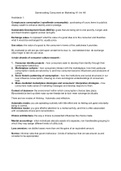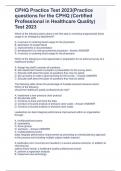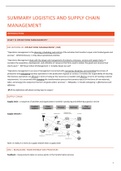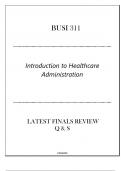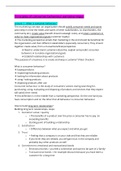Lecture 1. Well-being and performance at work – Veldhoven and Peccei
CONTEXTUALIZING INDIVIDUAL WELL-BEING AND PERFORMANCE AT WORK
A lot of research into individual well-being and performance because it develops over time and it is important to
progress it.
In the area of individual well-being and performance progress in recent decades has been triggered by a number of
developments:
1. More recognition of the multidimensionality of the constructs involved. Neither well-being or performance
at work can be described by a singular dimension!
2. Psychology has moved away from a narrow focus on negative feelings, thoughts and behaviors and there is a
rise of positive psychology. (Brings a more balanced account of wellbeing and performance.)
3. Several specific job settings have generated specific bodies of knowledge about factors involved in individual
wellbeing and performance.
4. The area of SHRM has (in past 25 years) transformed the way organizations are dealing with employees in
order to achieve organizational performance. (Also a lot of own research).
5. Multilevel research has enables researcher to start investigating empirically the linkage between
organizational and societal phenomena and employee level phenomena. New insights in old issues.
6. In classic approaches to job design, HRM, leadership, working conditions and employment relations the
worker is described as a passive recipient of societal, organizational and managerial initiatives, recent work is
emphasizing more and more the active role played by workers in shaping their job, their career, their
employment relations and their working conditions, as well as in shaping themselves as workers
Thus: a dynamic research area.
Terminology in the book:
no consensus in the field as to the exact definitions of the basic terms ‘well-being’ and ‘performance’.
Well-being at work refers to an individual’s affective state on the job. The core of this affective state relates
to feelings of happiness, health and the quality of social relationships.
- Broadening the well-being concept: behavioural and motivational components.
Work performance: distinction between the results of work versus the process of work
Context: The Oxford dictionary defines ‘context’ as the “circumstances that form the setting for an event,
statement, or idea, and in terms of which it can be fully understood.
Thus “all the circumstances that form the setting for individual well-being and performance at work, and in terms of
which these two constructs and their relationship can be fully understood”.
The context of well-being and performance at work
- Different lenses to which work can be examined. (For this book action-oriented)
Work is a “set of coordinated and goal-directed activities that are conducted in exchange for something else”
(Peeters, De Jonge & Taris, 2014, p. 4).
An action- oriented view puts these “work activities” at the center of the analysis. The coordinated (i.e. non-
random) actions of a worker are core to the definition of work. These actions are always in context.
Action theory: Seen from this perspective, the term context covers a rather wide range of factors that need to be
taken into consideration if one wants to understand work actions.
,This model presents the role of context for individual well-being and performance at work.
Work actions: (job performance). The proficient performance of core job tasks + wider contributions to the
work setting (OCB) .
- In action theory it is common not to emphasize the different target behaviors of employees, but instead to
emphasize the multiple types of regulation involved in keeping work actions targeted towards work-related
goals
Immediate work context: concerns all the situational elements that are necessary for and/or a direct part of
the work activities under analysis.
- Physical (goods, machines, locations tools)
- Social (Clients, co workers)
- Intangible (scripts, work order)
It is important that all situational elements need to fit together with worker characteristics, given the goals
and coordinated activities that are involved in work actions.
- Immediate work context varies between jobs.
Individual at work: demands of current work actions aimed at achieving a specific work goal depends on the
actual level of knowledge, abilities and skills of the worker + emotional, cognitive and energetic state. Work
action is not static cause it depends on differences in situational demands and constraints but also on
personal internal fluctuation. There is a large intra-individual variation in work, well-being and performance.
Captures the immediate skills, capabilities, motives and resilience of the individual worker as demonstrated
in ongoing
work activities.
Wider circumstances influencing work actions: Distal work context and distal personal context
Distal work context: This refers to the organizational and societal environment in which work takes place.
These factors impact on work in a more indirect way. They are more remote, setting the stage for or shaping
the immediate work context, but they are not actually a constituent part of the immediate work context as
such, or directly impinge on work action itself (i.e. regulation).
Example: the supervisor is not there (distal work context) but because work instructions and expectations
have been communicated (immediate work context) work continues.
Societal and organizational context factors.
Elements of distal work context
- Macro societal level: all work is to some extent influenced by legislation and institutions. Societal norms and
expectations, what is acceptable. Also organizational factors and actors that influence this.
- Branch of industry or sector: regulated working conditions/employment relations.
, Distal personal context : Any concrete work action needs to be understood in terms of a set of immediate
feelings, thoughts and behaviors that take place against a background of more stable personal factors and
dispositions.
- Stable personal and personality characteristics, private life circumstances, life experience, career history.
Linkages from the model
Distal work context (like societal and organizational context factors) shape immediate work context and influence
work, well-being and performance indirectly.
e.g. organizational initiatives aiming to promote customer orientation in salespeople influence the immediate work
context in a clothing store that is part of a larger chain by introducing scripts and expectations about how to deal
with customers. Regulation about work hours also is a example of immediate work context.
The distal work context also influences the individual at work.
e.g organizations policies, labor market and legislation effect labor contracts.
Wider personal context
e.g. Personal context factor (of the upcoming exam) may effect work actions that day through his state of mind
(individual at work) but also the kind of state of mind can affect immediate work context (think of job crafting)
Both immediate work context and individual at work influences work results (job performance) and work-related
well-being.
Work actions: work actions are linked with preventing work errors and development of work-related knowledge
abilities and skills that lead to work results.
Well-being: work activation has an influence on energy and strain levels. Link between work actions and feelings of
happiness.
Loops in the model:
Aggregate level results often have a feedback loop to the immediate and wider work contexts since
good collective results contribute to survival and to the munificence of the work environment.
Overall life well-being: a feedback loop, with positive life well-being contributing to the survival and resourcefulness
of the individual.
, Lecture 1. Grant et al. Work matters: job design in classic and contemporary
perspective
Some job changes can lead to more commitment, better performance, more satisfaction. Quantity and quality better
performance.
Job design: the set of opportunities and constraints structured into assigned tasks and responsibilities that affect
how an employee accomplishes and experiences work.
Today: job design is defined more broadly as encapsulating the processes and outcomes of how work is structured,
organized, experienced and enacted.
Job design as a theory rated simultaneously high in validity, importance and usefulness. Secondly it is a fundamental
component of the execution and experience of work. As a third, job design is an actionable feature of organizational
context (time and attention of managers to design the job) Job design is a valuable and scarce resource. Fourth, job
design is receiving a resurgence of attention as dramatic changes in domestic and international landschape of work
have created new types of job (service and knowledge work)
Where have we been? A selective history of job design research from past to present
Economic perspectives on the division of labor: Job design has its roots in economic perspectives on the
division of labor. More productivity if jobs are broken down in simple tasks. simplification, specialized
skills, efficient techniques, reduce distractions and time waste. More focus on well-being, satisfaction and
motivation of employees. (Hawthorne studies, theory x and theory y).
The human relations movement: efficiency was pursued at the expense of employee satisfaction and
motivation.
Emergence of job design enrichment: jobs being redesigned, enlarged and enriched to increase motivation
and satisfaction. Turner and Lawrence sic multidimensionsal task attributes: variety, autonomy, required
interaction, optional interaction on and off the job, required knowledge and skill, and responsibility. Some
associate task attributes: task identity, pay , working conditions, cycle time level of mechanization and capital
invesmten. Concluded that background may shape employees task preferences.
Job characteristics model
Influence of job characteristics on attitude and behaviors. The job characteristics are: task significance, task
identity, skill variety, autonomy and job feedback
- Task significance is the extent to which the job provides opportunities to have a positive impact on the well-
being of other people;
- task identity is the extent to which the job allows individuals to complete a whole, identifiable, visible piece
of work from start to finish;
- skill variety is the extent to which the job involves a wide range of capabilities and talents;
- autonomy is the extent to which the job provides freedom and discretion in how and when to do the work;
- and feedback is the extent to which the job itself provides clear, direct information about performance
effectiveness.
Hackman and Oldham (1975, 1976) argued that these five core job characteristics are objective properties of the
structure of employees' assigned tasks that influence their job perceptions.
CONTEXTUALIZING INDIVIDUAL WELL-BEING AND PERFORMANCE AT WORK
A lot of research into individual well-being and performance because it develops over time and it is important to
progress it.
In the area of individual well-being and performance progress in recent decades has been triggered by a number of
developments:
1. More recognition of the multidimensionality of the constructs involved. Neither well-being or performance
at work can be described by a singular dimension!
2. Psychology has moved away from a narrow focus on negative feelings, thoughts and behaviors and there is a
rise of positive psychology. (Brings a more balanced account of wellbeing and performance.)
3. Several specific job settings have generated specific bodies of knowledge about factors involved in individual
wellbeing and performance.
4. The area of SHRM has (in past 25 years) transformed the way organizations are dealing with employees in
order to achieve organizational performance. (Also a lot of own research).
5. Multilevel research has enables researcher to start investigating empirically the linkage between
organizational and societal phenomena and employee level phenomena. New insights in old issues.
6. In classic approaches to job design, HRM, leadership, working conditions and employment relations the
worker is described as a passive recipient of societal, organizational and managerial initiatives, recent work is
emphasizing more and more the active role played by workers in shaping their job, their career, their
employment relations and their working conditions, as well as in shaping themselves as workers
Thus: a dynamic research area.
Terminology in the book:
no consensus in the field as to the exact definitions of the basic terms ‘well-being’ and ‘performance’.
Well-being at work refers to an individual’s affective state on the job. The core of this affective state relates
to feelings of happiness, health and the quality of social relationships.
- Broadening the well-being concept: behavioural and motivational components.
Work performance: distinction between the results of work versus the process of work
Context: The Oxford dictionary defines ‘context’ as the “circumstances that form the setting for an event,
statement, or idea, and in terms of which it can be fully understood.
Thus “all the circumstances that form the setting for individual well-being and performance at work, and in terms of
which these two constructs and their relationship can be fully understood”.
The context of well-being and performance at work
- Different lenses to which work can be examined. (For this book action-oriented)
Work is a “set of coordinated and goal-directed activities that are conducted in exchange for something else”
(Peeters, De Jonge & Taris, 2014, p. 4).
An action- oriented view puts these “work activities” at the center of the analysis. The coordinated (i.e. non-
random) actions of a worker are core to the definition of work. These actions are always in context.
Action theory: Seen from this perspective, the term context covers a rather wide range of factors that need to be
taken into consideration if one wants to understand work actions.
,This model presents the role of context for individual well-being and performance at work.
Work actions: (job performance). The proficient performance of core job tasks + wider contributions to the
work setting (OCB) .
- In action theory it is common not to emphasize the different target behaviors of employees, but instead to
emphasize the multiple types of regulation involved in keeping work actions targeted towards work-related
goals
Immediate work context: concerns all the situational elements that are necessary for and/or a direct part of
the work activities under analysis.
- Physical (goods, machines, locations tools)
- Social (Clients, co workers)
- Intangible (scripts, work order)
It is important that all situational elements need to fit together with worker characteristics, given the goals
and coordinated activities that are involved in work actions.
- Immediate work context varies between jobs.
Individual at work: demands of current work actions aimed at achieving a specific work goal depends on the
actual level of knowledge, abilities and skills of the worker + emotional, cognitive and energetic state. Work
action is not static cause it depends on differences in situational demands and constraints but also on
personal internal fluctuation. There is a large intra-individual variation in work, well-being and performance.
Captures the immediate skills, capabilities, motives and resilience of the individual worker as demonstrated
in ongoing
work activities.
Wider circumstances influencing work actions: Distal work context and distal personal context
Distal work context: This refers to the organizational and societal environment in which work takes place.
These factors impact on work in a more indirect way. They are more remote, setting the stage for or shaping
the immediate work context, but they are not actually a constituent part of the immediate work context as
such, or directly impinge on work action itself (i.e. regulation).
Example: the supervisor is not there (distal work context) but because work instructions and expectations
have been communicated (immediate work context) work continues.
Societal and organizational context factors.
Elements of distal work context
- Macro societal level: all work is to some extent influenced by legislation and institutions. Societal norms and
expectations, what is acceptable. Also organizational factors and actors that influence this.
- Branch of industry or sector: regulated working conditions/employment relations.
, Distal personal context : Any concrete work action needs to be understood in terms of a set of immediate
feelings, thoughts and behaviors that take place against a background of more stable personal factors and
dispositions.
- Stable personal and personality characteristics, private life circumstances, life experience, career history.
Linkages from the model
Distal work context (like societal and organizational context factors) shape immediate work context and influence
work, well-being and performance indirectly.
e.g. organizational initiatives aiming to promote customer orientation in salespeople influence the immediate work
context in a clothing store that is part of a larger chain by introducing scripts and expectations about how to deal
with customers. Regulation about work hours also is a example of immediate work context.
The distal work context also influences the individual at work.
e.g organizations policies, labor market and legislation effect labor contracts.
Wider personal context
e.g. Personal context factor (of the upcoming exam) may effect work actions that day through his state of mind
(individual at work) but also the kind of state of mind can affect immediate work context (think of job crafting)
Both immediate work context and individual at work influences work results (job performance) and work-related
well-being.
Work actions: work actions are linked with preventing work errors and development of work-related knowledge
abilities and skills that lead to work results.
Well-being: work activation has an influence on energy and strain levels. Link between work actions and feelings of
happiness.
Loops in the model:
Aggregate level results often have a feedback loop to the immediate and wider work contexts since
good collective results contribute to survival and to the munificence of the work environment.
Overall life well-being: a feedback loop, with positive life well-being contributing to the survival and resourcefulness
of the individual.
, Lecture 1. Grant et al. Work matters: job design in classic and contemporary
perspective
Some job changes can lead to more commitment, better performance, more satisfaction. Quantity and quality better
performance.
Job design: the set of opportunities and constraints structured into assigned tasks and responsibilities that affect
how an employee accomplishes and experiences work.
Today: job design is defined more broadly as encapsulating the processes and outcomes of how work is structured,
organized, experienced and enacted.
Job design as a theory rated simultaneously high in validity, importance and usefulness. Secondly it is a fundamental
component of the execution and experience of work. As a third, job design is an actionable feature of organizational
context (time and attention of managers to design the job) Job design is a valuable and scarce resource. Fourth, job
design is receiving a resurgence of attention as dramatic changes in domestic and international landschape of work
have created new types of job (service and knowledge work)
Where have we been? A selective history of job design research from past to present
Economic perspectives on the division of labor: Job design has its roots in economic perspectives on the
division of labor. More productivity if jobs are broken down in simple tasks. simplification, specialized
skills, efficient techniques, reduce distractions and time waste. More focus on well-being, satisfaction and
motivation of employees. (Hawthorne studies, theory x and theory y).
The human relations movement: efficiency was pursued at the expense of employee satisfaction and
motivation.
Emergence of job design enrichment: jobs being redesigned, enlarged and enriched to increase motivation
and satisfaction. Turner and Lawrence sic multidimensionsal task attributes: variety, autonomy, required
interaction, optional interaction on and off the job, required knowledge and skill, and responsibility. Some
associate task attributes: task identity, pay , working conditions, cycle time level of mechanization and capital
invesmten. Concluded that background may shape employees task preferences.
Job characteristics model
Influence of job characteristics on attitude and behaviors. The job characteristics are: task significance, task
identity, skill variety, autonomy and job feedback
- Task significance is the extent to which the job provides opportunities to have a positive impact on the well-
being of other people;
- task identity is the extent to which the job allows individuals to complete a whole, identifiable, visible piece
of work from start to finish;
- skill variety is the extent to which the job involves a wide range of capabilities and talents;
- autonomy is the extent to which the job provides freedom and discretion in how and when to do the work;
- and feedback is the extent to which the job itself provides clear, direct information about performance
effectiveness.
Hackman and Oldham (1975, 1976) argued that these five core job characteristics are objective properties of the
structure of employees' assigned tasks that influence their job perceptions.


